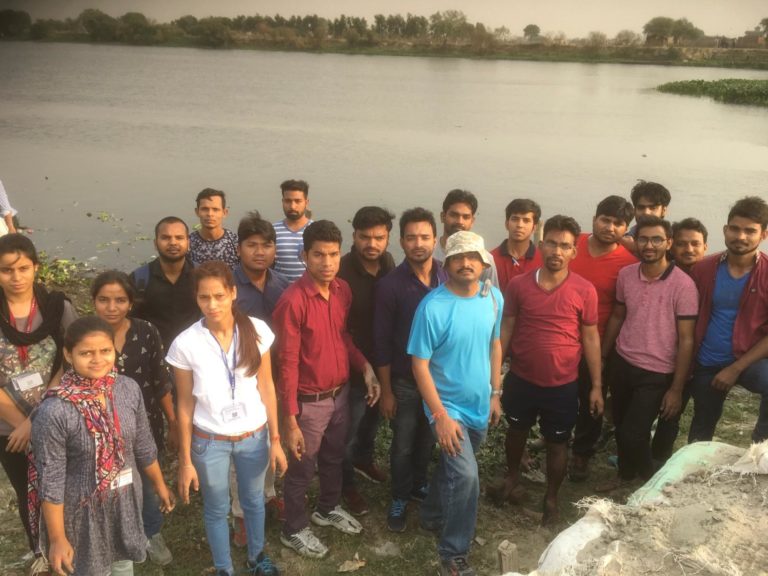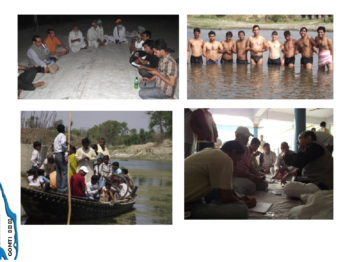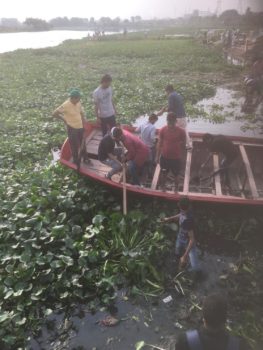
By Venkatesh Dutta, Gomti River Waterkeeper
Working as a Waterkeeper, having a strong sense of ‘social dynamics focus’ offers me invaluable experiences with real-world problems and communities. I feel motivated and rewarded when the outcomes of these projects positively impact the quality of life of people with no external funding.
Waterkeepers around the world are driven by astounding zeal and passion to do something meaningful for the water bodies and ecosystems they support. The passion drives them to make meaningful and positive impacts in their catchments. Whether they sue a polluter, find a solution against a wicked problem, or chart out strategies that will revolutionize the restoration of imperiled water ecosystems, their inspiration is a great start. But what is the best way to bring ideas to life? Creating a lasting impact with a successful restoration strategy takes more than mere ideation. It takes meticulous planning, self-discipline, grounded research, and a whole lot of effort… But it doesn’t always require unlimited funding and resources.
After working for more than two decades in the field of ecological restoration, often with people at the bottom of the pyramid, I have realized that many strong impacts and lasting projects are those which are not funded by external agencies—but which are done with self-motivation and with the support of the community. What’s more, the best solutions are usually nature-based solutions that do not require concrete, metals, and cement.
However, we need leaders who will take up the challenge of safeguarding our water resources—both for producing enough crops and for protecting our rivers, wetlands, lakes and their associated ecosystems. Governments must confront complex situations, with conflicts and contradictions resulting from increasing demands from people for multiple services under limited land and water availability. Sustainable water supply at desirable quality will be a huge challenge throughout the world.
I have trained people in watershed management techniques in diverse settings conducting large field surveys. I have also helped marginal communities and informal groups in several voluntary projects related to water and agriculture, and I greatly enjoy conversation outside of my workspace. The experience has helped me to frame questions and design corrective steps with better accuracy and reduced biases. Working as a Waterkeeper, having a strong sense of ‘social dynamics focus’ offers me invaluable experiences with real-world problems and communities. I feel motivated and rewarded when the outcomes of these projects positively impact the quality of life of people with no external funding.

Over the last fifteen years, I have spent at least 10 hours every week working with my community, sometimes giving back to them and many times getting enriched with new knowledge and experiences that this work brings. It has helped me to connect with people better and develop bottom-up approaches. In this process, the critical areas and bottlenecks that are part of projects with ‘no funds and high impacts’ have gradually emerged. Little by little, a small movement is initiated and spreads with community engagement, often with little central control, which is typical of an unaided project. The most important thing is to identify issue groups that are supportive, manage organically, and can help provide volunteers. Successful grassroots movements rely on collective action and wisdom building upon participatory engagement and action.
It is crucial to attend networking events and leverage creative and passionate people. Many grassroots civil societies are doing wonderful work which can help get our ideas off the ground. During my early days as a researcher, campaigner, and advocate for clean water, I met many amazing people. I sought advice and built meaningful and long-term relationships with them. By embracing challenges and charting out a thoughtful and innovative approach, I realized we can connect the dots together and move our building blocks on to success—without much of funding.
 Many years back, I decided to do a river expedition with my fellow friends – and made it a point that we will not stay in hotels or eat outside. We would be staying close to the river or with local farmers in the villages around the river. The response was overwhelming. We did not spend even a penny during our eight-day tour. We stayed with the villagers, ate with them and made our daily reports and assessments. The output was impressive—we made the restoration plan with communities that were long-standing and had great public support. The restoration plans have had a significant impact on the ecological culture, some of which have become sustainable platforms for river restoration issues. Ultimately, the river-expedition and its campaign had impressive results and reflected an inimitable capability to mobilize interest groups and engage communities for a common cause.
Many years back, I decided to do a river expedition with my fellow friends – and made it a point that we will not stay in hotels or eat outside. We would be staying close to the river or with local farmers in the villages around the river. The response was overwhelming. We did not spend even a penny during our eight-day tour. We stayed with the villagers, ate with them and made our daily reports and assessments. The output was impressive—we made the restoration plan with communities that were long-standing and had great public support. The restoration plans have had a significant impact on the ecological culture, some of which have become sustainable platforms for river restoration issues. Ultimately, the river-expedition and its campaign had impressive results and reflected an inimitable capability to mobilize interest groups and engage communities for a common cause.
I often work with people and organizations that have insufficient funds or no funds at all for their projects. They largely depend upon local support and voluntary work. In many cases, I encourage people to go out and get the community leaders, students and teachers on board, find the missing links between agenda and action and offer them a helping hand. With a deeper level of grounded research and a bit of optimism, it’s easy to create a model of advocacy, activism and grassroots engagement for one particular project and also for the organisation. Having gained little forward momentum with a strong desire to improve the world we live in, I can say that meaningful and long-lasting contributions can be made without much of a funding!